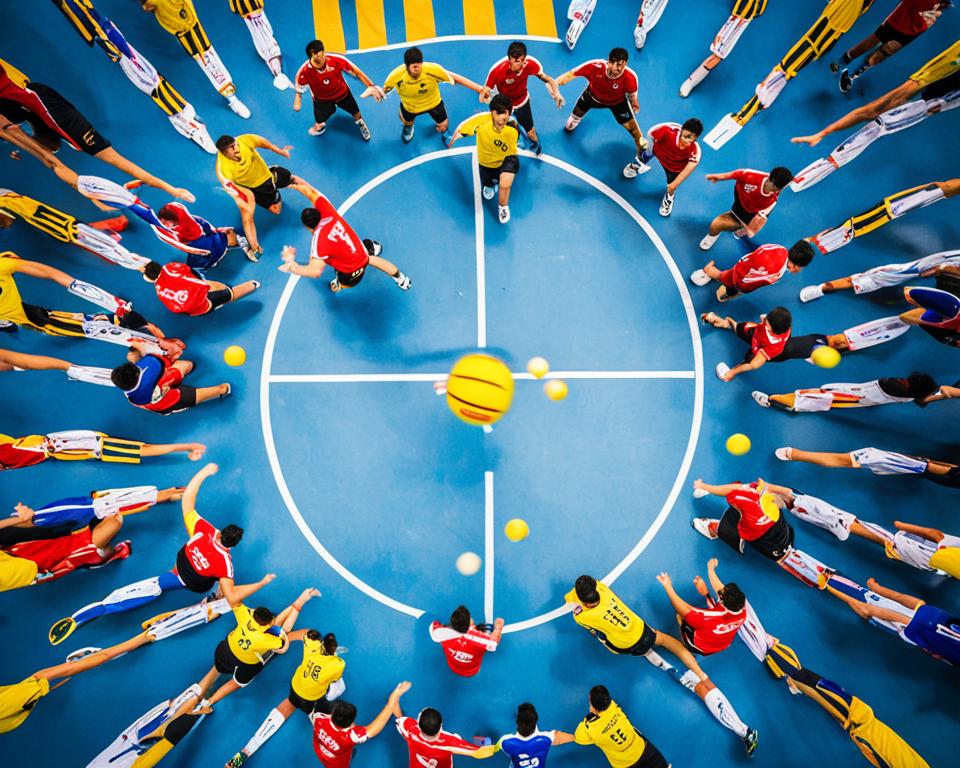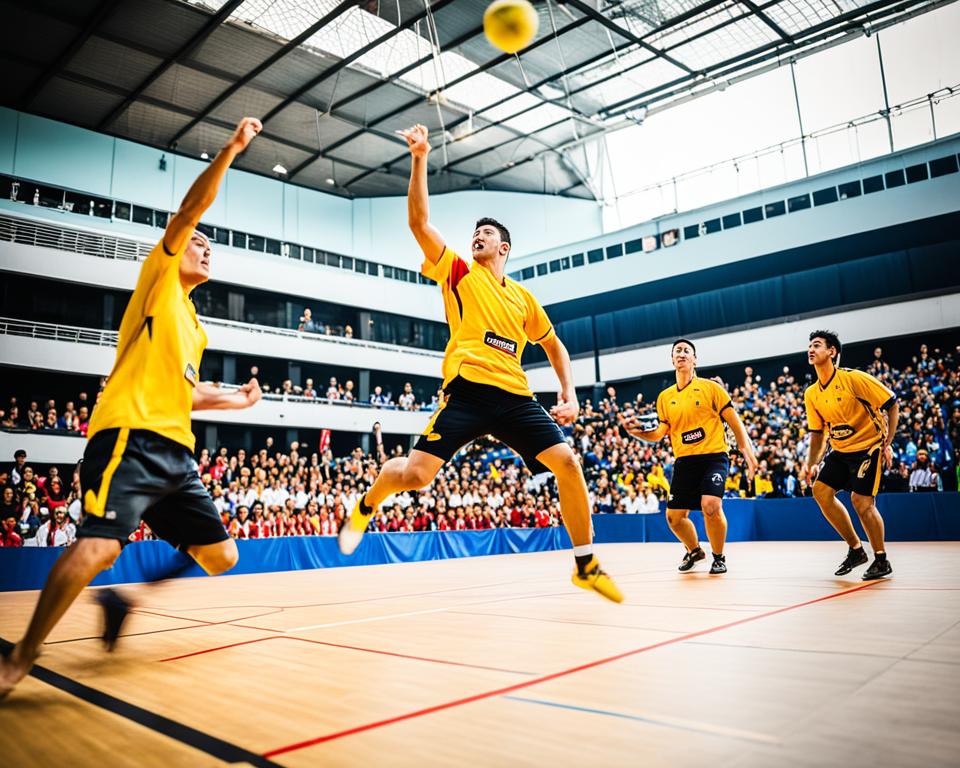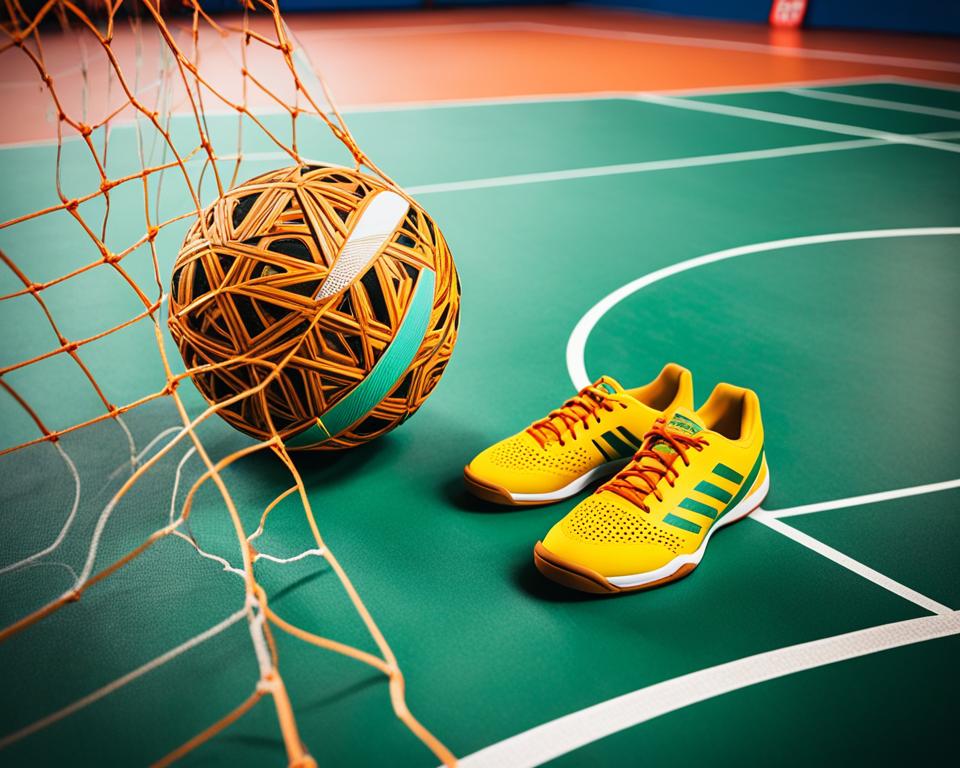Sepak Takraw is a traditional ball game from Southeast Asia. It’s an amazing mix of acrobatics, athleticism, and elegance. Imagine volleyball’s high net and strict ball-air rules combined with soccer’s no-hands twist. This creates a game full of skill and team play.
It’s super famous in Malaysia, called ‘Sepak Raga’, and Thailand, known as ‘Takraw’. The sport’s roots go back to the 15th century. Different versions are played in various Southeast Asian countries. By the 1940s, Sepak Takraw got its own set of rules and its official name.
Read more interesting information at ::zcr157602
Introduction to Sepak Takraw
Sepak Takraw is an exciting sport that mixes volleyball, football, and martial arts. It’s known for its dazzling moves and incredible teamwork.
The Mesmerizing Spectacle
This game is all about showing off cool kicks, stunning backflips, and high jumps. The players hit a special “sepak takraw” or “takraw ball” with their feet. It takes a lot of speed and skill to play this intriguing sport.
Blending Acrobatics, Athleticism, and Elegance
Players in Sepak Takraw are super athletic and can do some amazing tricks. They do kicks like the “Horse Kick” and powerful moves such as the “Roll Spike.” To do this, they need to be very quick, flexible, and coordinated. The game is really energetic and fun to watch because of all the athletic talents on display.
What is Sepak Takraw?
Sepak Takraw mixes the intense action of volleyball with the skill of soccer. Players use their feet, head, knees, and chest—but not hands—to keep the ball aloft. This combines into an exciting game of teamwork and strategy.
In 1960, teams from Malaysia, Singapore, Thailand, and Myanmar joined forces in Kuala Lumpur to set the game’s rules. Today, the International Sepaktakraw Federation looks after the sport since its establishment in 1988. It’s a big deal in Malaysia and was the national sport of the Philippines until 2009.3
Myanmar calls this sport “chinlone” and it’s been part of their culture for over 1,500 years. It’s influenced by ancient martial arts and dance. The game appeared in Malaysia back in the 15th century, probably gaining a lot of fans post-World War II till the mid-20th century across Malaya. The first Sepak Takraw match we know about was in Penang’s Swim Club in May 1945.
Sepak Takraw is like a blend of volleyball and soccer. It shares similarities with native games in Brunei, Indonesia, Malaysia, Singapore, the Philippines, Myanmar, Thailand, Laos, and Cambodia.
| Sepak Takraw Rules | Details |
|---|---|
| Game Structure | A usual game has three sets. Teams need to win two sets to win the match, each set is to 21 points. |
| Team Composition | Each team has three players. Among them, one acts as the tekong from the back of the court. |
| Player Movement | Once the tekong serves, players can move as they like on the court. |
| Ball Control | Before sending it back over the net, players can only touch the ball once. They can use any part of their body, except arms, to return the ball. |
History and Origins
Sepak Takraw comes from ancient Southeast Asian cultures. It was both a game and a way to stay fit. The sport likely began in the Malay Peninsula in the 15th century. It quickly spread to places like the Philippines. Over the years, Sepak Takraw became very popular in nations including Malaysia, Thailand, Indonesia, and the Philippines. Today, many countries in Southeast Asia see it as a national sport. It has also grabbed the world’s attention.
Ancient Southeast Asian Civilizations
The first mention of sepak takraw was in the 15th century in Malaysia. Its name means “to kick a rattan ball” in Malay and Thai. This shows how deeply it is tied to the area’s history and culture.
Evolution and Popularity Across Nations
In the 1940s, the game changed into its modern form. The first real competition was in Penang on May 16, 1945, at a Swim Club. By 1960, it was organized and standardized in Kuala Lumpur, Malaysia. Officials from Malaysia, Singapore, Thailand, and Myanmar did this work. It was previously called Sepak Raga Jaring.
Sepak Takraw has different names in various nations. Examples include SIPA in the Philippines, SEPAK in Thailand, and RAGO in Indonesia. Since its start in 1965 at the Southeast Asian Games, Malaysia and Thailand have been very successful in Sepak Takraw. The Palawan province in the Philippines is known for its talented Sepak Takraw players.
Rules and Gameplay
In Sepak Takraw, two teams with three players each battle it out. The court is 13.4 x 6.1 meters, like a big badminton court, and the net stands at 1.5m for men and 1.42m for women. The aim is to kick the sepak takraw ball over the net and keep it off the ground on the other team’s side. You can use your legs, head, knees, and chest, but not your hands.
Team Composition and Court Structure
Sepak Takraw is a game for two teams of three. The special Sepak Takraw ball has 12 holes and 20 points where they meet. Players show off their quickness, flexibility, and teamwork. They use cool kicks and actions to keep the sepak takraw ball in the air.
Objective and Scoring System
Each game has three sets. The first team to 21 points in a set wins. Teams can hit the ball three times before sending it over. The team that wins two out of three sets wins the match.
Acrobatic Techniques and Skills
Sepak Takraw players are known for their incredible moves and acrobatics. They perform amazing kicks and maneuvers like the “Horse Kick,” “Sunback Spike,” and “Roll Spike.” To do this, players need superb agility, flexibility, and coordination. They use these skills to keep the ball airborne with fast and accurate hits. This makes watching Sepak Takraw very exciting.
Gravity-Defying Kicks and Moves
The game’s acrobatics are truly amazing. Players use moves like the hard “Horse Kick Serve” and the impressive “Sunback Spike.” They also perform the “Roll Spike,” which is a backflip kick, showing off their great skills. These feats demonstrate the physical abilities of Sepak Takraw players.
Agility, Flexibility, and Coordination
Sepak Takraw requires a unique type of athlete. Players must have excellent agility, flexibility, and coordination. These skills help keep the ball moving precisely in the air. The sport helps them develop these talents, leading to stunning acrobatic displays.
Cultural Significance
Sepak Takraw is very important in Southeast Asia. It’s deeply tied to the region’s past and traditions. It’s more than just fun; it represents pride and who the people are. People love watching tournaments, which are big celebrations. They shout and cheer for their teams. The game teaches players to work as a team, be disciplined, and helps in forming strong bonds. Beyond borders, it brings nations together, promoting friendship and unity.
National Pride and Identity
9 Across Southeast Asia, Sepak Takraw is more than a sport. It’s played in celebrations and other community events. It unites people, showing their shared culture and history. This makes it a strong force that joins everyone together.
Camaraderie, Discipline, and Teamwork
1 This sport is all about working together and discipline. Players learn to support each other on and off the field. The skills they gain are very important in life. That’s why Sepak Takraw is valued so much throughout Southeast Asia.

Global Recognition
Sepak Takraw has become known worldwide, not just in Southeast Asia. The International Sepak Takraw Federation (ISTAF) started in 1988. They work hard to make the sport more popular everywhere. It’s now in big international sports events, like the Asian Games. Plans are in place to get more people around the world to know about it. Sepak Takraw is becoming famous globally. It shows off amazing skills and different cultures.
International Sepak Takraw Federation (ISTAF)
The ISTAF oversees how Sepak Takraw grows and gets known around the world. They aim to share the sport with as many people as possible. To do this, the ISTAF organizes big tournaments like the ISTAF World Cup. They also work with local groups to help the sport grow. These actions by the ISTAF are making Sepak Takraw more popular worldwide.
Inclusion in Multi-Sport Events
Being part of big multi-sport events, like the Asian Games, has really helped Sepak Takraw. It has let people from all over see how talented Sepak Takraw players are. It’s also a way to show the sport to new fans.9 Now, there are plans to include Sepak Takraw in more big sports events. This will keep helping the sport to grow and become even better known.
Sepak Takraw Equipment
In Sepak Takraw, the main gear is a rattan ball, also called a “sepak takraw” or “takraw ball.” These balls are hand-woven and have 12 holes and 20 points of contact. They need to be around 42-44 cm (men) or 43-45 cm (women) in size. For weight, men’s balls are 170-180 grams, and women’s are 150-160 grams.
The sport is played on a court that’s about twice the size of a badminton court. It measures 13.4 x 6.1 meters. A net runs through the middle, standing at 1.5m for men and 1.42m for women.
For safety, players have to wear special helmets with face shields. This protection is important because it’s a fast and risky game.
| Equipment | Specifications |
|---|---|
| Rattan Ball | – 12 holes, 20 intersections – Circumference: 42-44 cm (men), 43-45 cm (women) – Weight: 170-180 grams (men), 150-160 grams (women) |
| Net | – Width: 0.7 meters – Length: Minimum 6.10 meters – Height: 1.52 meters (men), 1.42 meters (women) |
| Court | – Dimensions: 13.4 x 6.1 meters – Boundary lines: Maximum 4 cm width |
| Player Gear | – Lightweight shoes with flat soles – Protective gear: Ankle bands, forehead bandanas |
The Sepak Takraw court is as large as a doubles badminton court. Its dimensions are 13.4 by 6.1 meters. The boundary lines around the court are no more than 4 centimeters wide.
Players need to have good shoes. They wear lightweight shoes with flat soles. This helps them have a strong grip on the court. They also use protective gear to keep safe. Ankle bands and forehead bandanas are used to prevent injuries and keep sweat out of their eyes.
Sepak Takraw Strategies
Sepak Takraw is all about strategy and quick thinking. Teams use both attack and defense to outplay opponents. The Inside Kick helps in controlling the ball well. On the other hand, the Outside Kick is great for blocking by sending the ball up fast. The Knee Kick is a solid defense against serves. It uses the thigh area to stop the ball.
Offensive and Defensive Tactics
Offense means finding the right moment to kick and aiming accurately. Defense is about reading the opponent, placing players right, and breaking their game. The Header is a special move involving the forehead to hit the ball. It comes in handy when a normal kick is too hard or impossible.
Team Coordination and Communication
Teamwork and clear talk are key in Sepak Takraw. Players need to work smoothly to move the ball towards the other side.The Horse Kick Serve shows off flexibility with a strong, high kick. Meanwhile, the Sunback Spike requires a one-leg jump and a powerful strike, demanding perfect timing. The Roll Spike stands out with a jump, mid-air flip, and a kick over the shoulder, making it a tough and flashy move to pull off.
Sepak Takraw Tournaments and Competitions
Sepak Takraw tournaments are big deals that draw in keen fans and talented players from worldwide. The biggest show is the ISTAF World Cup, put on by the International Sepak Takraw Federation. You also see local and regional contests, where teams from places like Thailand and Malaysia are usually on top. These events really highlight the sport’s top-notch skills, making it more known and respected.
The King’s Cup Sepak Takraw Championship kick-started in 1985 in Bangkok, Thailand. It’s a big deal on the international scene. Malaysia and Thailand mostly win here. Around the 25th time it happened, in 2010, there were 23 teams competing. This championship normally happens in Bangkok, with different numbers of events each year. Some folks think it’s unfair because only Thai teams can join, suggesting the Asian Games as a more level field.
1992 was the year ISTAF, the International Sepaktakraw Federation, was first set up to guide the sport globally. The men started their championship in 1992. The women’s turn came in 2005. Malaysia was the first King’s Cup champion in 1985. They struck again in 1988. The 35th King’s Cup is awaiting 2022 in Bangkok, Thailand

| Tournament | Inaugural Year | Number of Editions | Dominant Champions |
|---|---|---|---|
| ISTAF World Cup | N/A | N/A | N/A |
| King’s Cup Sepak Takraw Championship | 1985 | 35 | Malaysia, Thailand |
Sepak Takraw Players and Teams
Sepak Takraw has seen many great players and teams. Thailand’s teams lead the way in both the men’s and women’s ISTAF World Cup. Their players are famous for mastering tough moves in the sport.
One shining star is Anuwat Chaichana. He holds numerous gold medals and is hailed as one of the sport’s top players ever. Teams from Malaysia, Indonesia, and the Philippines have also helped spread the sport’s fame.
Champion Players and Their Achievements
Many players in Sepak Takraw have reached high levels of success. Anuwat Chaichana from Thailand is one of them. He has won many gold medals, especially in the ISTAF World Cup.
People consider Chaichana as one of the best due to his skill in the sport’s hardest moves.
Renowned Sepak Takraw Teams
Sepak Takraw has not only produced star players but also top teams. Thailand’s teams shine in both men’s and women’s divisions at the ISTAF World Cup. This shows Thailand’s extensive talent and dedication to the sport.
Malaysia, Indonesia, and the Philippines have also had standout teams, adding to the sport’s worldwide growth.
Sepak Takraw Associations and Governing Bodies
The sport of Sepak Takraw is watched over by many groups around the world. At the top is the International Sepak Takraw Federation (ISTAF). They make sure the sport grows globally and runs big events like the ISTAF World Cup. Each country, like Malaysia and Thailand, has its own group to look after Sepak Takraw within its borders. All these groups are key to making sure Sepak Takraw remains popular and keeps getting better.
The ISTAF started in 1988 with support from Malaysia, Thailand, Singapore, Indonesia, and Myanmar. In Singapore, the Persekutuan Sepak Raga Singapura (PERSES) manages sepak takraw. It has been doing so since 1959, making sure the sport thrives in Singapore. The ISTAF has nearly 50 member groups mostly in Asia and Oceania, with more wanting to join. It connects 54 national groups from Asia & Oceania, North America, South America, Africa, and Europe.
The King’s Cup Sepaktakraw World Championship is a big event since 1985, thanks to Thailand’s Takraw Association. Thailand often wins big at the ISTAF World Cup. The elite ISTAF SuperSeries’ first event was in Bangkok, 2011. It’s one of the top tours for Sepak Takraw.
In Singapore, PERSES grooms young players from various schools for Sepak Takraw. They hold matches and guide the national team. In Singapore, the Asian Sepaktakraw Federation (ASTAF) and the ISTAF work together at the regional and global level.
Conclusion
Sepak Takraw is an amazing sport from Southeast Asia. It combines skill, beauty, and the region’s culture. Now, 31 clubs play this sport, showing its growing popularity.
It’s not just for sports fans. If you’re interested in new activities, Sepak Takraw is a top choice. It highlights the best of people, their cultures, and the beauty of traditional sports. You can enjoy it outdoors, indoors, or even at the beach, making it great for everyone.
Its story begins long ago, as a fun way to stay fit in ancient times. Since its standardization in 1960, it has grown a lot. Now, it’s part of big international sports events, bringing a taste of the world together.
